

What is the CogAT?
The Cognitive Abilities Test, commonly known as the CogAT, is a widely used assessment tool designed to measure a student’s cognitive abilities. Developed by psychologists and educators, this test evaluates reasoning and problem-solving skills across three key domains: verbal, quantitative, and nonverbal. Rather than focusing on learned knowledge, the CogAT provides insights into a student’s innate cognitive capabilities.
The Three Pillars: Verbal, Quantitative, and Nonverbal Abilities:
- Verbal Abilities:
- Assessing a student’s command of language, vocabulary, and verbal reasoning skills.
- Understanding how well a student can express and comprehend ideas through language.
- Quantitative Abilities:
- Evaluating a student’s grasp of mathematical concepts, logical reasoning, and problem-solving skills.
- Measuring the ability to manipulate numerical information and identify patterns.
- Nonverbal Abilities:
- Exploring a student’s capacity for spatial reasoning, visualization, and pattern recognition.
- Gauging problem-solving skills without relying on language-based cues.
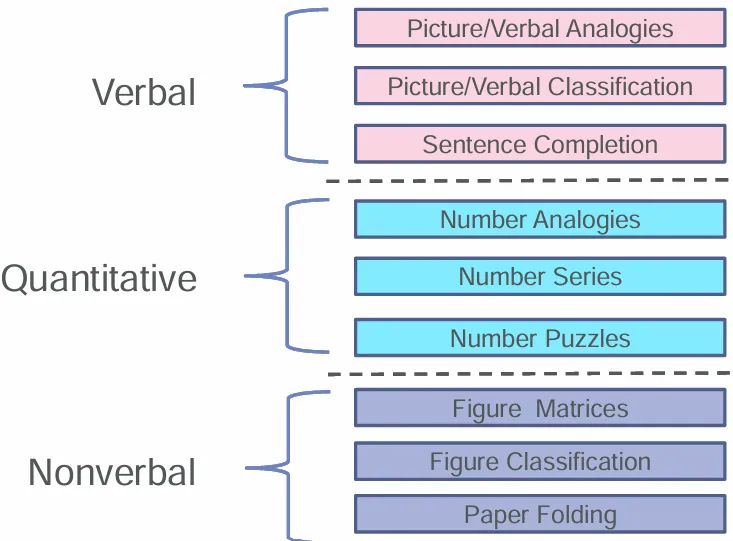
Prepare your child to tackle all nine CogAT question categories with ease. Wizdomi can help build your child’s confidence! To learn more check this.
Which CogAT Level Will My Child Take?
Navigating the realm of cognitive assessments often sparks questions about which level of the Cognitive Abilities Test (CogAT) is most suitable for your child. The CogAT is designed for various age groups, each corresponding to a specific level. Let’s delve into the key considerations to help you determine the appropriate CogAT level for your child.
Age and Grade: CogAT levels are aligned with specific age groups and grades. Consider your child’s age and grade level to identify the corresponding CogAT level.
| Grade | CogAT Test Level | Number of Questions | Test Time |
|---|---|---|---|
| Kindergarten | Level 5/6 | 118 | 112 Minutes |
| 1st Grade | Level 7 | 136 | 112 Minutes |
| 2nd Grade | Level 8 | 154 | 112 Minutes |
| 3rd Grade | Level 9 | 170 | 90 Minutes |
| 4th Grade | Level 10 | 176 | 90 Minutes |
| 5th Grade | Level 11 | 176 | 90 Minutes |
| 6th Grade | Level 12 | 176 | 90 Minutes |
| 7th – 8th Grade | Level 13/14 | 176 | 90 Minutes |
| 9th – 10th Grade | Level 15/16 | 176 | 90 Minutes |
| 11th – 12th Grade | Level 17/18 | 176 | 90 Minutes |
School Placement Policies:
Consult with your child’s school or educational institution to understand their policies regarding CogAT testing and grade-level placements.
CogAT Question Samples
Level 5/6-8 Verbal Battery Picture Analogy
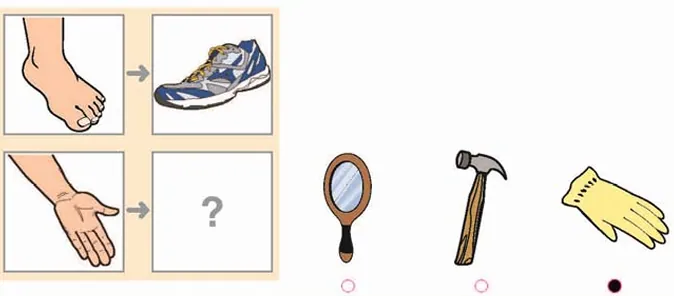
Level 5/6 & 7 Quantitative Battery Number Puzzle
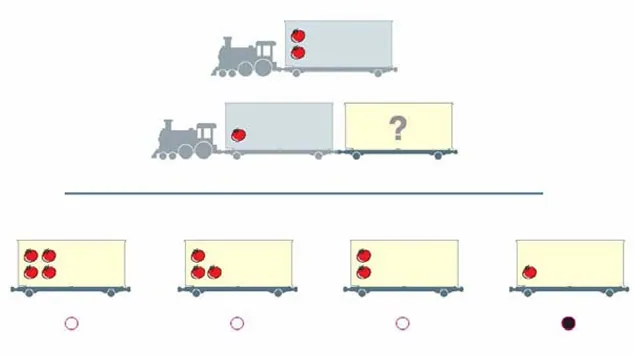
Level 5/6 & 7 Quantitative Battery Number Puzzle

Level 5/6 Nonverbal Battery Paper Folding
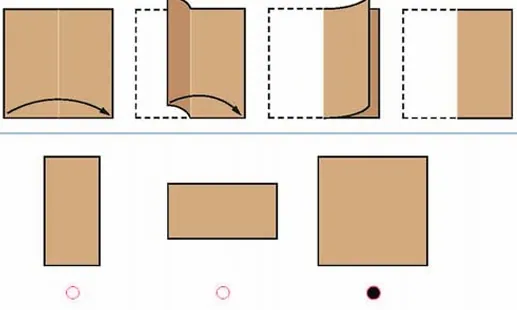
Level 5/6-8 Nonverbal Battery Figure Matrices
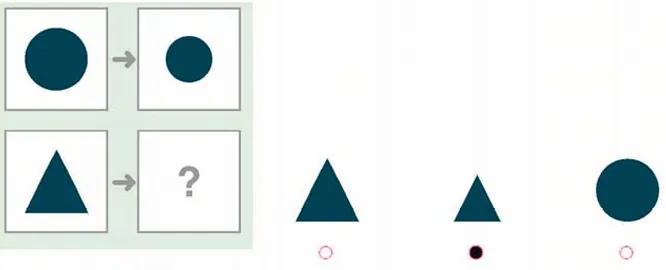
Nonverbal Subtests
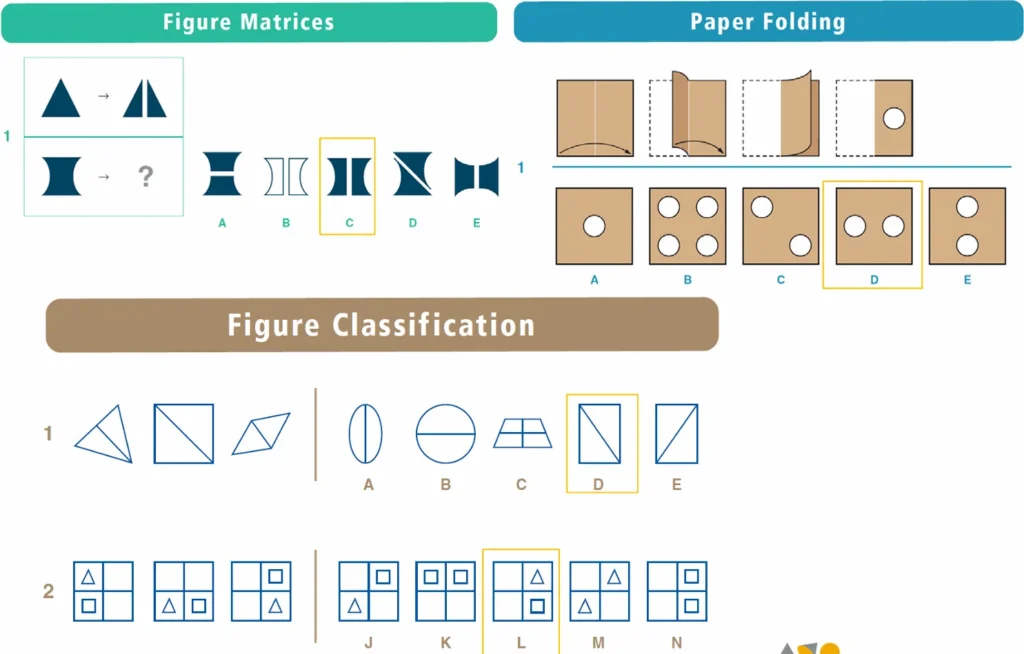
How is the CogAT Scored?
Understanding how the CogAT is scored can be helpful for parents and students alike. Here’s a breakdown of the scoring process:
Raw Scores:
- Each correct answer on the test receives one point.
- No points are deducted for incorrect answers.
Scaled Scores:
- Raw scores are then converted into scaled scores ranging from 1 to 160.
- This conversion process accounts for the difficulty of each question, ensuring scores are comparable across different test forms and grade levels.
Standard Age Scores (SAS):
- Scaled scores are further converted into SAS scores with a mean of 100 and a standard deviation of 16.
- This allows for age-based comparisons, meaning a score of 100 represents average performance for a child of that age.
Stanines:
- Stanines are another way to interpret CogAT scores. They are a standardized score on a scale of 1 to 9, with 5 representing average performance and other numbers indicating varying degrees below or above average.
Score Report:
- Your child’s individual score report will typically include:
- Raw scores for each section of the test.
- Scaled scores for each section.
- Standard Age Scores (SAS) for each section and a composite score.
- Stanines for each section and a composite score.
- A percentile rank indicating how your child performed compared to their peers across the nation.
Understanding the Score Report:
- Look beyond the overall score and focus on individual section scores to identify your child’s strengths and weaknesses.
- Interpret scores within the context of the normative data provided in the report, considering factors like age and grade level.
- Remember, the CogAT is just one piece of information and should be considered alongside other data points like your child’s academic performance, teacher observations, and individual learning styles.
If you have further questions or concerns about your child’s score report, it’s always recommended to speak with their teacher or school counselor. They can provide additional insights and guidance based on your child’s specific context.
How to Prepare for the CogAT Test: Tips for Parents and Students
While the CogAT shouldn’t be a source of undue stress, some preparation can help your child feel confident and comfortable on test day. Here are some tips for parents and students:
For Parents:
- Familiarize yourself with the test: Understand the format, content areas, and time limits of the CogAT for your child’s grade level. Resources like the official CogAT website and your child’s school can provide this information.
- Communicate openly with your child: Explain the purpose of the test and emphasize that it’s a way to assess their strengths and areas for growth. Reassure them that their performance doesn’t define them.
- Create a calm and supportive environment: Ensure your child gets adequate sleep and feels well-rested on test day. Provide a healthy breakfast and encourage them to relax and do their best.
- Practice test-taking skills: There are various online resources and practice books available that can help your child familiarize themselves with the format and types of questions they might encounter on the test. However, remember, these resources should be used for familiarization, not for pressuring your child to achieve a specific score.
For Students:
- Get a good night’s sleep before the test.
- Eat a healthy breakfast on test day.
- Arrive at the testing location on time and prepare with necessary materials.
- Read each question carefully and take your time.
- Don’t be afraid to skip a question and come back to it later if you need more time.
- Use logical reasoning and problem-solving skills to answer the questions.
- Stay calm and focused throughout the test.
Additional Tips:
- Focus on building your child’s overall cognitive skills: Encourage activities like reading, solving puzzles, playing logic games, and engaging in creative projects. These activities can help develop critical thinking, problem-solving, and reasoning skills that are beneficial not just for the CogAT but also for overall academic success.
- Maintain a positive attitude: Encourage your child to approach the test with a positive mindset and focus on doing their best.
Remember, the CogAT is just one measure of your child’s abilities. By providing support, encouragement, and fostering a love for learning, you can help them reach their full potential regardless of their test scores.

